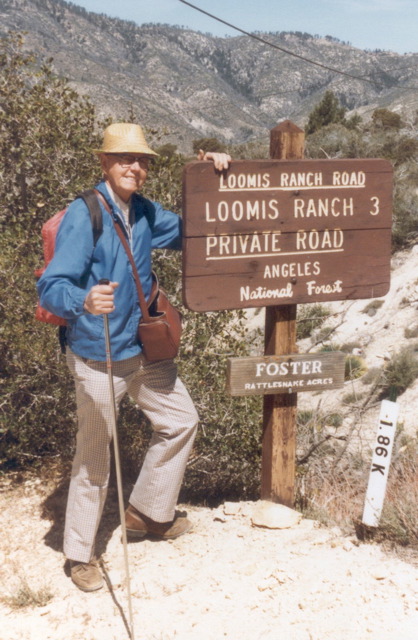Rattlesnake Acres
[Editor's Note: The methods used by Captain Loomis to treat snakes bites are not recommended,
and may prove hazardous to one's health. This is a historical recollection only, and not meant as
medical advice. Medicine has progressed significantly since the 1920s, and medical facilities are
much more accessible.]
Ranch life was not without it's share of hazards; one of the more common to humans and animals were rattlesnake bites. During their first few years in Alder Creek, Captain Loomis claimed to see 40 or 50 rattlesnakes a year. In his journal, he related a number of tales about his run-ins with the deadly reptiles. As with most emergencies on the ranch, these incidents were dealt with locally, and dismissed as a necessary price for the otherwise idyllic life they had chosen.
Captain Loomis had killed many rattlesnakes and always tried to figure out just what they would and could do. In his journal he wrote:
"I have never yet found one that can
strike over one-half of the length of their body and I
can't remember a case where the rattler didn't try it's
best to get away. The only dangers I can see is in
stepping on them or when reaching down getting too close
for their comfort. Most people have an idea that snakes
will deliberately lie in wait for them and that they can
jump a good many feet. My treatment against their bites
is a simple one. I take a sharp knife and make a 3/8"
deep incision cutting lengthways and away from bites
– squeeze all blood from cuts and if you happen to
have permanganate of potash rub a few crystals into
wounds. I was bitten twice by rattlesnakes once in the
leg, once in an arm and had no serious affects
whatsoever. It is my belief that those who die do so from
fright, not from the snake poison."
"On my way to the mine I had cut some
firewood in Arrastra Canyon – about a mile from
home – which I packed home on burros. After it was
all brought in my wife in walking up that way noticed
that I had left a lot of fine stuff and bark, both of
which she likes to use in the wood burning stove we use
up here. Whenever we were out in the hills on a walk she
had made it a practice to bring in a piece of bark or
wood. This has become a habit with both of us.
She asked me to go up and bring the small stuff down but
I was busy with something else so I didn't do it. So one
morning she and her grandson Lester, who was then about 5
years old – saddled up one of four burros, took a
lunch, and said they were going on a picnic. Lester came
walking in some time during the afternoon. I knew that
something was the matter so I asked him "Where 's
grandma?" In his slow, deliberate way he replied "Oh,
she's a coming" and added a while after very unconcerned
"she was bitten by a rattlesnake".
I went into the house quickly, got my first aid kid and
started up the trail. I soon met her – she came
walking along slowly – holding her arm, trying to
cut off circulation. I took her into the house and lanced
the two bites on the forefinger of her right hand. Then I
used a hypodermic needle to inject a solution of
permanganate of potash into the wound. The hand and arm
kept swelling so I cut clear to bone the second time and
had her keep her hand in the solution of permanganate.
She felt pretty sick for a few days, the action of the
poison ... affecting her right shoulder & throat.
After my first treatment and when she had become somewhat
comfortable, I went back up to Arrastra Canyon. My wife
had told me where the burros were and that she had been
bitten when picking up a nice piece of bark. When I got
up there I found the rattlesnake still in the place she
had told me. I dispatched the snake and brought the
burros back. While I was gone she had written a letter to
each of her children for fear that she might die of the
effects of the bite – but she was as well as before
a week afterwards."
The story "Rattlesnakes" provides Grace's version of her rattlesnake bite tale.

Unidentified man posing beside Loomis Ranch sign, c. 1980.
Note "Rattlesnake Acres" sign.
Dick Worsfold Collection, Sierra Club-Angeles Chapter Archives
[Sources: Lester Loomis Journal - Wandalee Thompson Collection (2002.1.23)]